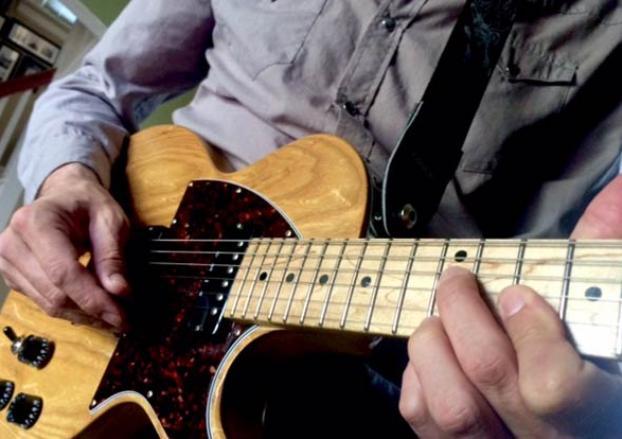Jazz Guitar Corner: Building a Jazz Vocabulary — Melodic Minor Over iim7
Look at three licks that use melodic minor over a iim7 chord.

When studying jazz guitar, we often begin by exploring the Dorian mode when soloing over m7 chords.
But, while that is a great first-choice scale, we often stop there in our exploration of m7 chord vocabulary. One of the mostly widely used scales besides Dorian to solo over m7 chords is the melodic minor scale, which is built like a Dorian but with a natural rather than a b7 note. When that raised 7th, a C# over Dm7, for example, is heard, it creates a sense of tension that is then released throughout the line, which is a big key in creating the jazz-guitar sound, tension and release.
In today’s lesson, we’ll look at three licks that use melodic minor over a iim7 chord. We'll also explore ways you can practice this scale over m7 chords in your jazz-guitar practice routine.
Melodic Minor Scale iim7 Lick 1: The first example we’ll look at in terms of using melodic minor over a iim7 chord features a classic pattern over the first bar of this ii V I phrase. Here, you are starting on the 9th of Dm7, going up and then back down until you reach the major 7th interval, C#, which then leads you into a descending DmMaj7 arpeggio. The rest of the lick is pretty straight-forward, with a bit of chromaticism over the G7 chord for good measure.

Melodic Minor Scale iim7 Lick 2: In this second lick, you can see the same pattern as Lick 1, but this time raised an octave over the Dm7 chord. Since this pattern is used a lot in the jazz-guitar vocabulary, and in multiple position/octaves on the guitar, it’s worth looking at in both octaves during today’s lesson.
Playing it in different registers also will propel you into different material over the next bar of any tune you are soloing over, including here, where I keep the D melodic minor scale going over the G7 chord, producing a G7#11 sound throughout that bar. This trick, using the ii melodic minor, D melodic minor in this case, over the iim7 and V7 of a ii V I progression is a great way to bring a MM sound to your lines but not have to change scales between those two chords. A musical win-win!

Melodic Minor Scale iim7 Lick 3: The last lick in this lesson uses the melodic minor over Dm7 in a way that encloses the root, D, of the chord. From there, the G7 features a few 4th intervals and some chromatic notes. The rest of the line has a few bebop patterns thrown in for good measure.

Melodic Minor Over iim7 Exercises: Besides knowing that you can use melodic minor over a iim7 chord, and working out the above three licks in 12 keys at various tempos, here are some of my favorite ways to practice applying melodic minor scales to m7 chords in the practice room.
- Play a Dm7 chord on the guitar and sing the related melodic minor scale; repeat in 12 keys.
- Put on a Dm7 vamp backing track and solo using only D melodic minor. Repeat in 12 keys and at multiple tempos.
- Solo over a modal tune such as “So What” or “Milestones” and use only the melodic minor scale for each m7 chord in those tunes.
- Put on a ii V I backing track and solo over the iim7 chord using its related melodic minor scale. Repeat in 12 keys.
- Put on a ii V I backing track and solo over the iim7 and V7 using the ii melodic minor scale for both chords. Repeat in 12 keys. As you can see, just by changing one note in the Dorian scale, raising the b7 to a natural 7, you can bring a whole bunch of new sounds to your m7 and ii-V soloing ideas by focusing on the melodic minor scale rather than the Dorian mode.
Matt Warnock is the owner of mattwarnockguitar.com, a free website that provides hundreds of lessons and resources designed to help guitarists of all experience levels meet their practice and performance goals. Matt lives in the UK, where he is a senior lecturer at the Leeds College of Music and an examiner for the London College of Music (Registry of Guitar Tutors).
Get The Pick Newsletter
All the latest guitar news, interviews, lessons, reviews, deals and more, direct to your inbox!
Matt Warnock is the owner of mattwarnockguitar.com, a free website that provides hundreds of lessons and resources designed to help guitarists of all experience levels meet their practice and performance goals. Matt lives in the UK, where he teaches Skype guitar students all over the world, and is an examiner for the London College of Music (Registry of Guitar Tutors).
“There are so many sounds to be discovered when you get away from using a pick”: Jared James Nichols shows you how to add “snap, crackle and pop” to your playing with banjo rolls and string snaps
Don't let chord inversions bamboozle you. It's simply the case of shuffling the notes around







![Joe Bonamassa [left] wears a deep blue suit and polka-dotted shirt and plays his green refin Strat; the late Irish blues legend Rory Gallagher [right] screams and inflicts some punishment on his heavily worn number one Stratocaster.](https://cdn.mos.cms.futurecdn.net/cw28h7UBcTVfTLs7p7eiLe.jpg)


